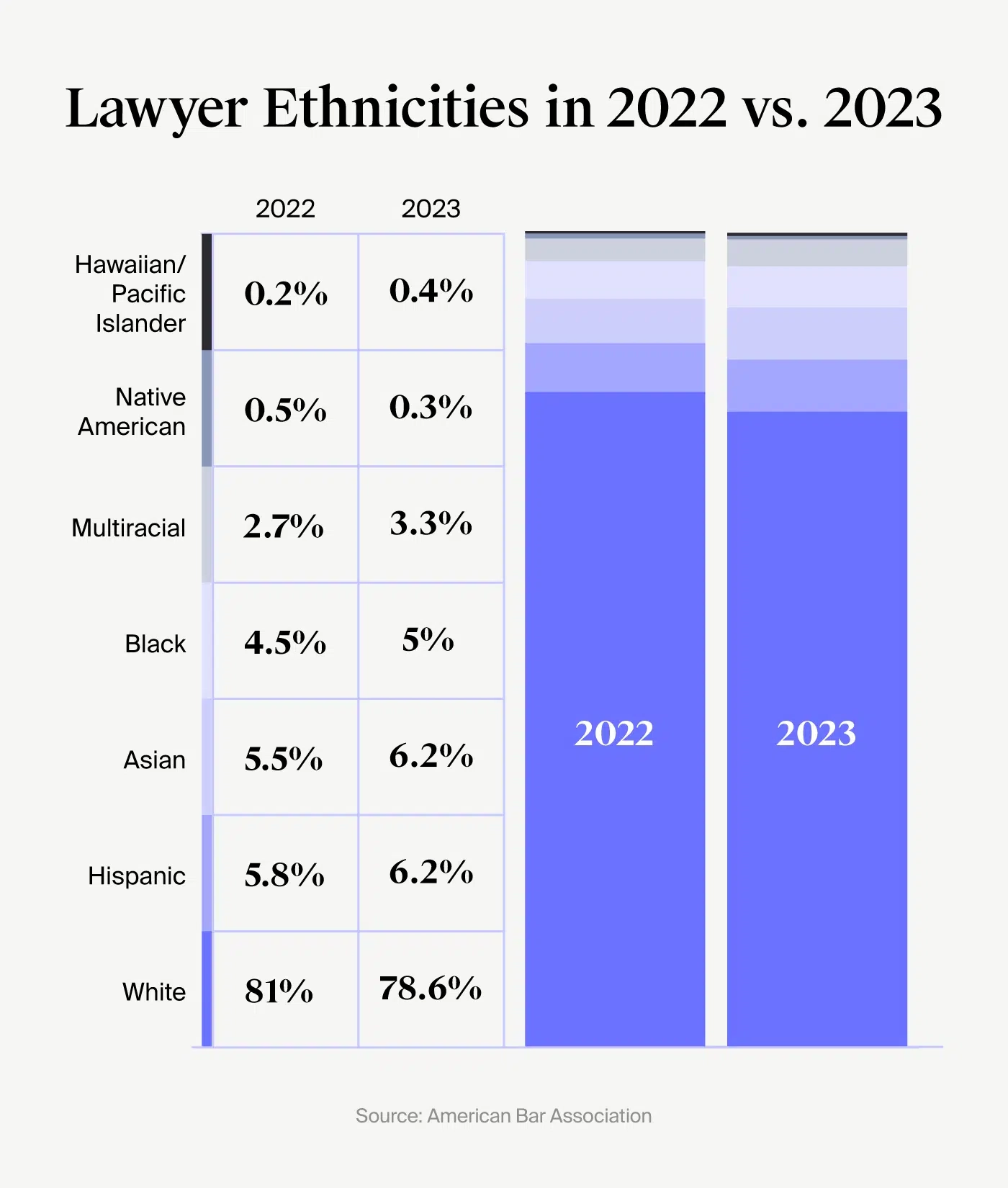Key takeaways
Getting paid was the most challenging function (15%) for legal professionals in 2023, but our customers collected 33% more from clients who paid using online payments. (2024 Legal Industry Trends Report)
Law firm accounting was the second most challenging function (12%) in 2023, but 46% of legal professionals who use legal accounting software say it saves them 1-5 hours each week. (2024 Legal Industry Trends Report)
Only 24% of legal professionals in 2023 said their law firm had adopted legal-specific generative AI tools, but 55% had plans to adopt additional generative AI tools. (2024 Legal Industry Trends Report)
The primary reasons law firms did not adopt generative AI in 2023 were not knowing enough about it (52%), concerns about ethical issues (39%), and lack of trust in the results (39%). (2024 Legal Industry Trends Report)
The legal industry continues to evolve each year. With AI, and specifically generative AI, settling into the legal tech space, law firms adopting more technology, and client expectations shifting, it can be tough to keep up with the latest changes.
Understanding the state of the industry can help your law firm stay ahead of the curve. Below, we’ll go over 65 lawyer statistics around labor, legal demographics, technology, finance, and stress. Sourced from our 2024 Legal Industry Trends Report, the U.S. Bureau of Labor Statistics, and more, these statistics provide a snapshot of the industry and shed light on upcoming trends.
Lawyer Labor Statistics
The future looks bright for lawyers as the profession is expected to grow over the next decade. If you’re planning to start a law firm, it’s natural to have a few questions. How many law firms are there in the U.S.? What’s the average lawyer’s salary? Understanding these questions and how your location and practice area can impact your projected earnings are crucial. Below, you’ll learn about the current state of the industry’s labor and wages.
There were an estimated 731,340 lawyers employed in the U.S. in 2023. (U.S. Bureau of Labor Statistics)
The average hourly rate for lawyers wage for lawyers was $84.84 in 2023. (U.S. Bureau of Labor Statistics)
The average annual lawyer salary was $176,470 in 2023. (U.S. Bureau of Labor Statistics)
The top five states with the most lawyers in 2023 were California (94,300), New York (86,000), Florida (61,320), Texas (45,950), and the District of Columbia (34,660). (U.S. Bureau of Labor Statistics)
Lawyer employment is projected to grow 5% between 2023 and 2033. (U.S. Bureau of Labor Statistics)
The lawyer profession is projected to have 35,600 openings on average each year between 2023 and 2033. (U.S. Bureau of Labor Statistics)
There were 428,302 law firm businesses in the U.S. in 2023. (IBISWorld)
The highest-paid lawyers were patent lawyers, with a national average annual salary of $171,346 (as of April 18, 2024). (Indeed)
The top-paying states for lawyers in 2023 were the District of Columbia ($238,990 average annual salary), California ($213, 860 average annual salary), Delaware ($212,360 average annual salary), New York ($208,480 average annual salary), and Connecticut ($195,730 average annual salary). (U.S. Bureau of Labor Statistics)

Lawyer Demographics Statistics
Although older white men have represented the majority of lawyers over the years, the workforce is becoming increasingly diverse. More women and people of color are pursuing this career, and these groups grew between 2022 and 2023. Learn more about the current demographic breakdown of lawyers below.
39% of women were lawyers in 2023 compared to 38% in 2022. (American Bar Association Profile of the Legal Profession 2023)
32% of federal judges are women in 2023. (American Bar Association Profile of the Legal Profession 2023)
The median age of lawyers was 46 in 2023. (U.S. Bureau of Labor Statistics)
35 to 44-year-olds made up about 29% of lawyers in 2023 and represented the largest age group in the profession. (U.S. Bureau of Labor Statistics)
20 to 24-year-olds made up about .3% of lawyers in 2023 and represented the smallest age group in the profession. (U.S. Bureau of Labor Statistics)
In 2023, 78.6% of lawyers were white, compared to 81% in 2022. (American Bar Association Profile of the Legal Profession 2023)
In 2023, 6.2% of lawyers were Hispanic, compared to 5.8% in 2022. (American Bar Association Profile of the Legal Profession 2023)
In 2023, 6.2% of lawyers were Asian, compared to 5.5% in 2022. (American Bar Association Profile of the Legal Profession 2023)
In 2023, 5% of lawyers were Black, compared to 4.5% in 2022. (American Bar Association Profile of the Legal Profession 2023)
In 2023, 3.3% of lawyers were multiracial, compared to 2.7% in 2022. (American Bar Association Profile of the Legal Profession 2023)
In 2023, .3% of lawyers were Native Americans, compared to .5% in 2022. (American Bar Association Profile of the Legal Profession 2023)
In 2023, .4% of lawyers were Hawaiian or Pacific Islander, compared to .2% in 2022. (American Bar Association Profile of the Legal Profession 2023)

Technology and AI Statistics
Gone are the days of file cabinets, paper checks, and illegible time-tracking scribbles on your legal pad. Today’s technology can take tedious tasks and turn them into streamlined functions that help your firm save time and money. Choosing the right legal technology providers is especially crucial to ensure easy adoption and compliance. We’ll go over the top technology and AI legal statistics below.
The top three uses for generative AI in 2023 were brainstorming (58%), drafting correspondence (55%), and general research (46%). (2024 Legal Industry Trends Report)
42% of legal professionals who adopted generative AI tools used it every day, 29% once per week, and 24% once a month or less in 2023. (2024 Legal Industry Trends Report)
The top three reasons law firms adopted general-use generative AI tools like ChatGPT and Bing Chat in 2023 was to increase overall productivity (75%), cost-savings and efficiency (51%) and replace some admin functions (28%). (2024 Legal Industry Trends Report)
Only 2% of law firms who used general-use generative AI tools in 2023 said they adopted it to replace a lawyer. (2024 Legal Industry Trends Report)
77% of legal professionals in 2023 said generative AI increased their productivity. (2024 Legal Industry Trends Report)
Only 20% of legal professionals said cost was the primary reason their firm didn’t use generative AI technologies in 2023. (2024 Legal Industry Trends Report)
The top three reasons that prevented legal professionals from learning about and researching new software tools for their firm in 2023 were that the research process is too time-consuming (44%), they have no need for new software (33%), and there’s not enough unbiased information available (28%) (2024 Legal Industry Trends Report)
The top three least challenging functions for law firms in 2023 were eFiling (75%), taking online payments (70%), and secure texting (62%). (2024 Legal Industry Trends Report)
28% of law firms used legal accounting software rather than consumer accounting software in 2023. (2024 Legal Industry Trends Report)
58% of law firms used an online texting tool (without the use of a personal cellphone) in 2023. (2024 Legal Industry Trends Report)
44% of law firms who used online text messaging saved 1-2 hours each week, 17% saved 3-5 hours, and 9% saved 5 hours in 2023. (2024 Legal Industry Trends Report)
Only 16% of law firms used rules-based calendaring software in 2023. (2024 Legal Industry Trends Report)
37% of law firms who used rules-based calendaring software saved 1-2 hours each week, 15% saved 3-5 hours, and 10% saved 5+ hours in 2023. (2024 Legal Industry Trends Report)
Our customers captured 58,395 leads from MyCase’s customized lead intake forms in 2023. Of these leads, 10,286 became clients. (2024 Legal Industry Trends Report)
In 2023, 33% of law firms using a virtual receptionist gained 1-2 leads a week, 21% gained 3-5, and 19% gained 5+. (2024 Legal Industry Trends Report)
23% of law firms using a virtual receptionist in 2023 saved 10+ hours each month, 20% saved 6-10 hours, and 43% saved 1-5 hours. (2024 Legal Industry Trends Report)
91% of law firms had the ability to eFile in 2023. (2024 Legal Industry Trends Report)
34% of law firms who used eFilling in 2023 saved 1-2 hours each week, 27% saved 3-5 hours, and 26% saved 5+ hours. (2024 Legal Industry Trends Report)

Billing, Payments, and Finances Statistics
Law firm financial management was probably the last thing that came to mind when becoming a lawyer. Routinely reconciling accounts, keeping track of time and expenses, and following up on client payments are parts of the job that law school likely did not cover. However, these functions are necessary to improve your law firm’s profitability and stay financially afloat. These law statistics shed light on how law firms are managing their finances and what tools they use to streamline their processes.
65% of law firms used online time-tracking software in 2023. (2024 Legal Industry Trends Report)
When using time-tracking software, 47% of law firms captured 1-5 more hours each week, 20% captured 5-10 more hours, and 11% of law firms captured 10+ more hours in 2023. (2024 Legal Industry Trends Report)
When using passive time-tracking software that runs in the background to track work done, 50% of law firms said they captured 1-5 more hours each week, 16% captured 5-10 more hours, 6% captured 10-20 more hours, and 4% captured 20+ more hours in 2023. (2024 Legal Industry Trends Report)
Our customers who used our Smart Time Finder tool in 2023 captured an additional 579,665 hours, which amounts to an additional $22,425 in billable hours per lawyer (assuming a $330 hourly rate). (2024 Legal Industry Trends Report)
78% of law firms accepted online payments via credit/debit cards in 2023. (2024 Legal Industry Trends Report)
Of the law firms that accepted online payments, 19% saw a $10,000+ increase in their average monthly collection rates in 2023. (2024 Legal Industry Trends Report)
Legal professionals saw a 50% increase in their invoice recovery rate when using online payments compared to 17% for checks and cash in 2023. (2024 Legal Industry Trends Report)
51% of law firms charged for consultations in 2023. Of those who charge, 89% accept online payments via credit/debit card. (2024 Legal Industry Trends Report)
Our customers collected nearly $17 million from consultation fees paid online compared to about $2 million collected by cash and check in 2023. (2024 Legal Industry Trends Report)
56% of law firms set up payment plans for their clients in 2023. (2024 Legal Industry Trends Report)
48% of law firms who set up payment plans in 2023 said they collected more money throughout the lifetime of a case compared to when they didn’t offer them. (2024 Legal Industry Trends Report)
The average payment plan is 258 days based on MyCase data in 2023. (2024 Legal Industry Trends Report)
Only 19% of law firms offered a “Pay Later” legal fee financing option in 2023, but 47% say they can accept more cases by offering this option. (2024 Legal Industry Trends Report)
The average time to receive the first payment after lead intake for all practice areas was 38 days in 2023. (2024 Benchmark Report: Part 2)
The average time to receive the first payment after lead intake for law firms in the traffic practice area was 8 days in 2023. (2024 Benchmark Report: Part 2)
The average time to receive the first payment after lead intake for law firms in the personal injury practice area was 184 days in 2023. (2024 Benchmark Report: Part 2)
Learn about the basics of financial wellness and how you can help your law firm financially thrive.
Download Webinars
Lawyer Stress Statistics
Being a lawyer is one of the most rewarding professions. However, non-stop work and challenging cases also make it one of the most difficult. Lawyers typically work long hours due to the complex nature of the role and tight deadlines that they must meet. Below, we’ll include a few statistics about lawyer stress and the impact of it.
55% of lawyers in 2021 say that their workplace supports their mental health needs. (American Bar Association)
46% of lawyers in 2021 said their firm provides resources on addiction, substance abuse, or other mental health services. (American Bar Association)
51% of lawyers in 2021 said they take adequate breaks throughout the workday, but 28% said they did not. (American Bar Association)
27% of lawyers in 2021 said they feel pressure not to take vacation time. (American Bar Association)
63% of lawyers in 2021 said they make time for themselves. (American Bar Association)
39% of lawyers in 2021 say they often work long hours. (American Bar Association)
40% of lawyers in 2021 say their firm’s support for working parents is very good. (American Bar Association)
82% of lawyers in 2021 said technology makes it easier to balance work and family obligations. (American Bar Association)
83% of lawyers in 2021 said their firm offers flexible hours to work outside of the typical 9-5 workday. (American Bar Association)
Learn More About the Legal Industry
The legal industry today looks much different than it did a decade ago. Technology has especially made a major wave in the legal industry in the past few years, and it’s likely to continue in the coming years. Modernizing the legal industry can serve to make law firms more efficient, cost-effective, and secure—all while delivering better results for clients.
MyCase’s cloud-based law firm practice management platform has all of the tools, automation, and AI-enhanced processes to increase productivity while also improving the client experience. Our solution includes client intake and lead management, case management, client communication, and financial management all in one platform.
Schedule a free MyCase demo today to learn how our solution can transform your law firm and streamline your processes.
About the author

Esther ParkContent Writer
Esther Park is a content writer and Senior SEO Manager for leading legal software companies, including MyCase, Docketwise, and CASEpeer, as well as LawPay, the #1 legal payment processor. Her expertise lies in writing about emerging legal technologies and financial wellness strategies for law firms, among other topics.
